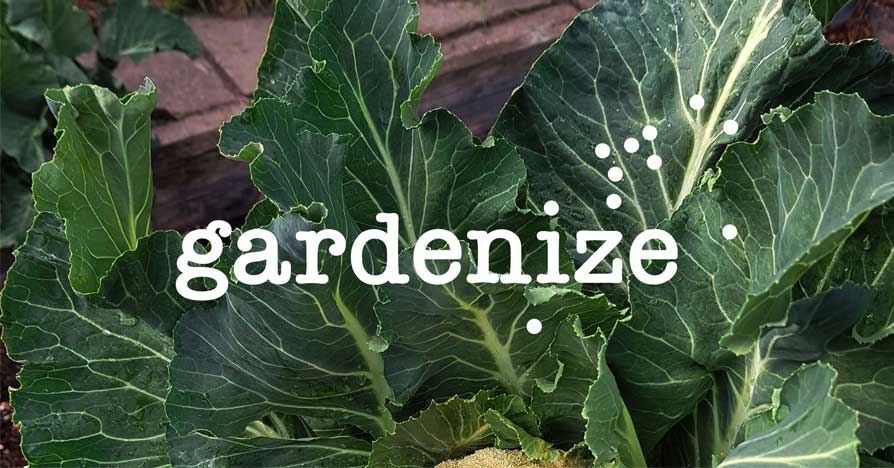Upside-down gardening: November in Central Otago
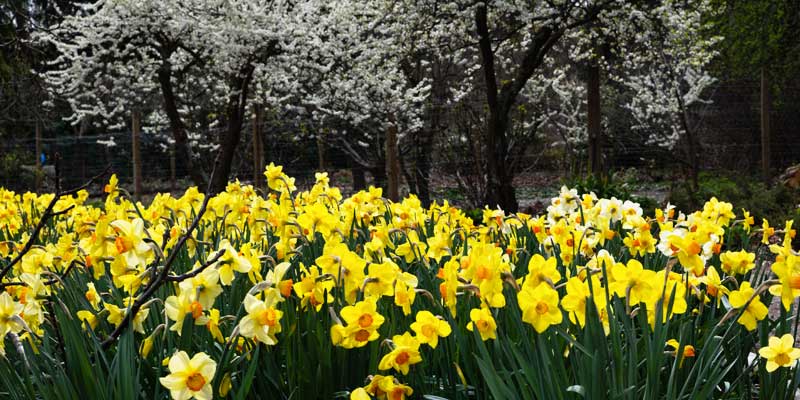
Garden Inspiration
Plants for places, acid and alkaline soil, garden design ideas, the naming of plants, and seeds to sow in November.
Tour of local gardens
Each year in Alexandra, local gardeners make their gardens available for other people to look at, as part of a planned tour. I’m very conscious that my garden tends to reflect my English style of gardening. As a change from showing you my garden, I thought you would enjoy sharing the lessons I learned on this year’s tour, which made me think about garden design that is uniquely New Zealand.
Plants that grow well in this area
The spring displays were dominated by just a few species: blossoming fruit trees, hellebores, trilliums, pulmonaria, daffodils, tulips and muscari.
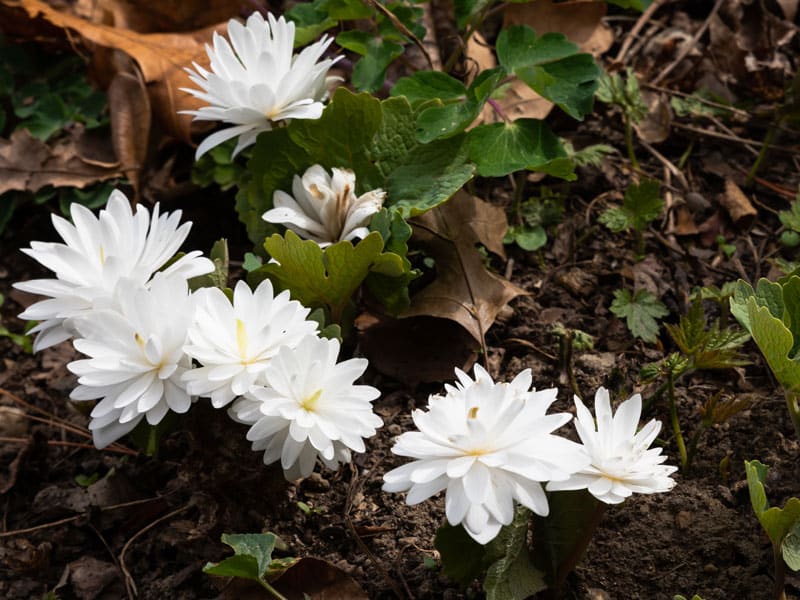
A special plant
This double bloodroot (sanguinaria) belongs to a friend who has recently bought a property with an established woodland garden containing rhododendrons and camellias. It is hard to find this for sale, but it can be found in a few local gardens, because relatives and friends have given pieces of it to each other over the years. It originates in eastern North America and grows from bright orange rhizomes. The red sap it produces is what gave it its name. Because it contains toxins, including some that damage the skin, it is best to wear gloves when handling it.
Fruit trees
Central Otago is known for its beautiful orchards and expertly grown fruit, so most gardens have at least one fruit tree. This peach blossom was in a small orchard right next to a beautiful garden.

Trilliums
Another popular woodland plant from North America is the trillium. We saw a variety of them on the tour. This one’s red flowers shining in the sun are highlighted by a red-leaved heuchera nearby. We noticed that trilliums appear more striking when they are allowed to form a large clump, giving the garden a well-established appearance.
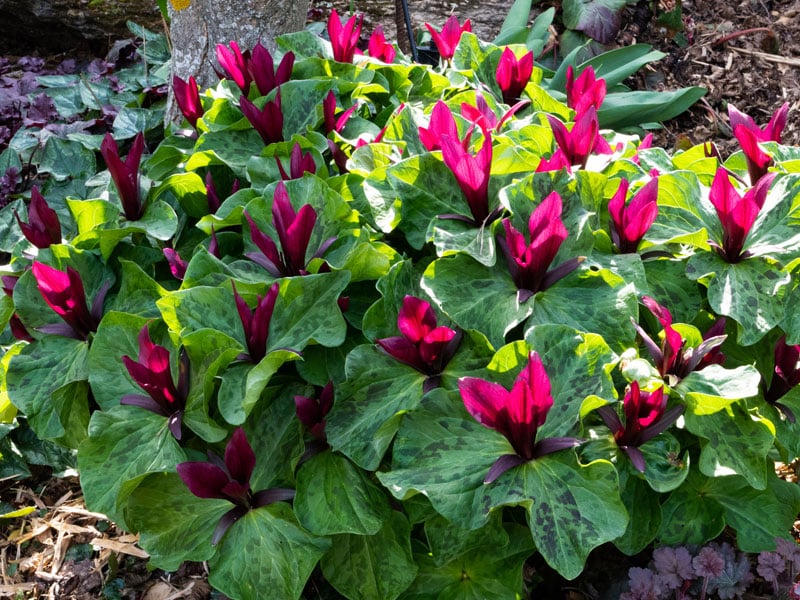
Pulmonaria
Pulmonaria or lungwort gets its name from its lung-shaped leaves, which are often spotted like the air spaces in a lung. “Wort” in a plant’s name usually indicates that in the past, it was grown for healing. The doctrine of signatures, which is the idea that a plant which resembles a body part or organ will heal that body part or organ began in classical times and is reflected in many plant names. We saw a wide range of different pulmonarias, including white, claret, pure blue and a mixed pink and blue one. I’d like to begin a collection of different varieties to extend the range of colours in my spring garden.

Stunning camellias
In our semi-arid conditions, deeper levels of soil here can be alkaline because the lime produced by weathering doesn’t get washed away by rain: great for vineyards, not so great for acid-lovers like camellias and rhododendrons. Organic matter increases the acidity of the soil, especially if you use pine needles. This healthy camellia, in its mature garden fed over years with leaf litter, put on a stunning show.
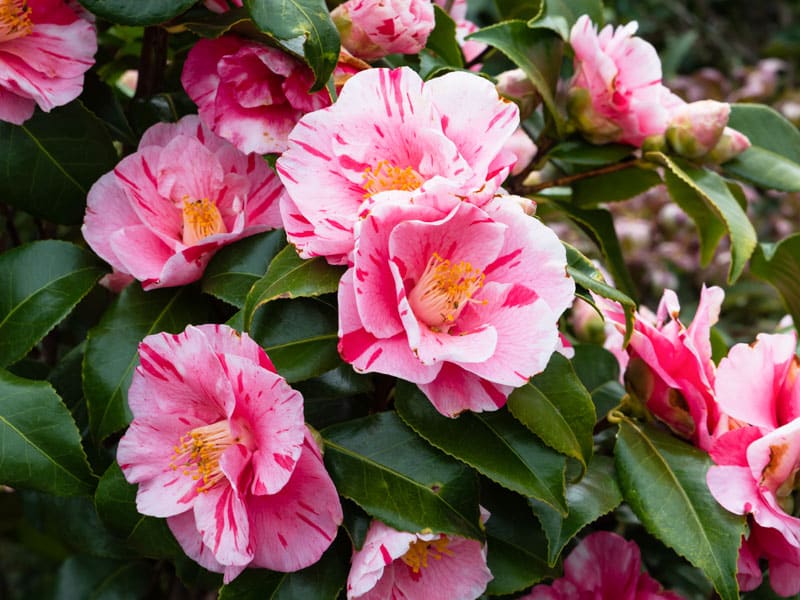
The show must go on
It rarely snows at the altitude where we live, but we had an unusually late fall of snow in early October. I couldn’t resist including this image taken by my husband showing our tulips continuing to put on a show.
Garden design ideas
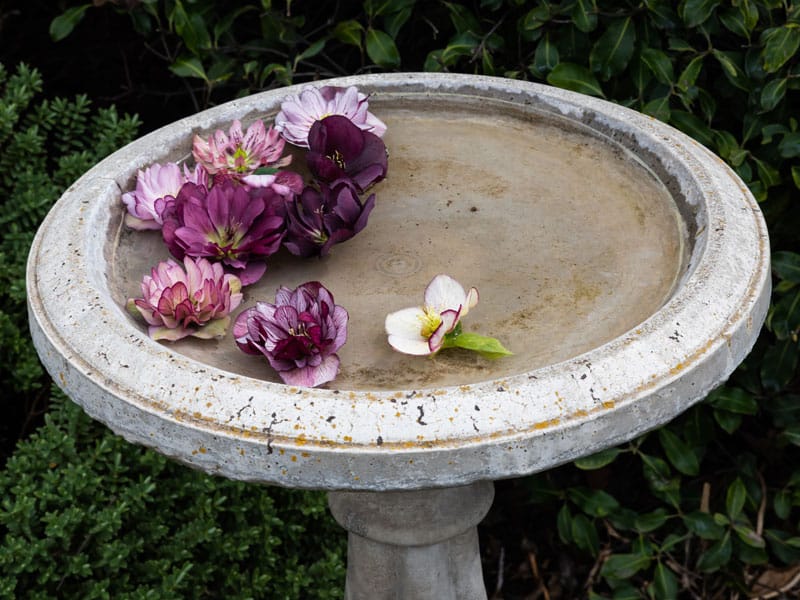
How to display hellebores
The flowers of most hellebores face downwards, so you have to turn them upwards with your hand to see their wonderfully varied colours and forms. This gardener solved that problem by displaying their hellebore flowers in a bird bath that also featured some beautiful yellow lichen: a testament to our clean air.
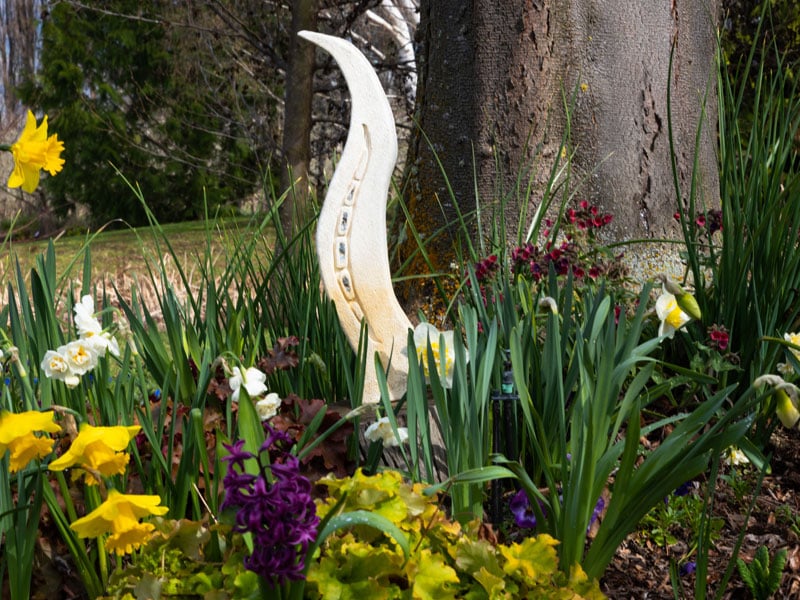
Garden sculpture
These daffodils, heuchera and claret-coloured pulmonaria are set off well by this maori-inspired Oamarau stone carving with its inset paua shell.
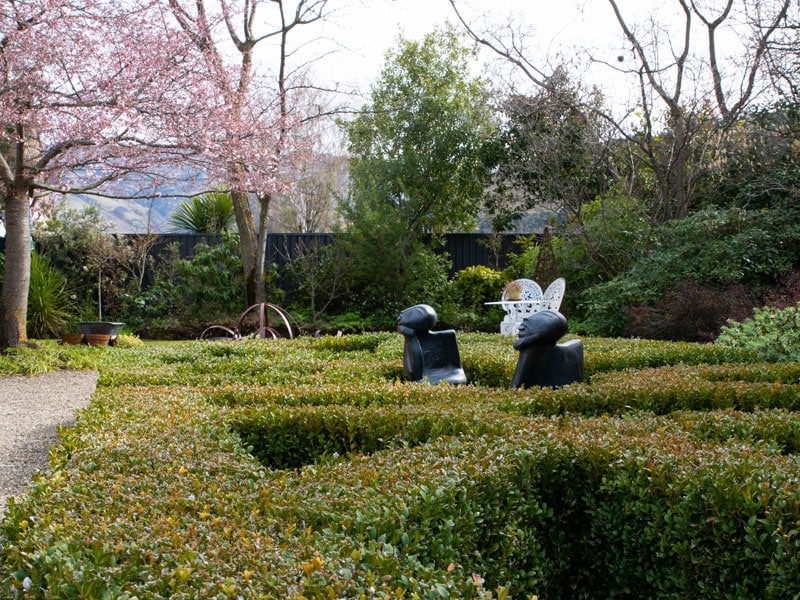
Enviably ordered design
I lack the self-discipline ever to produce the glossy magazine-ready look achieved by this box knot garden, enhanced by tasteful garden sculpture, where traditional European planting meets pasifika-influenced sculpture.
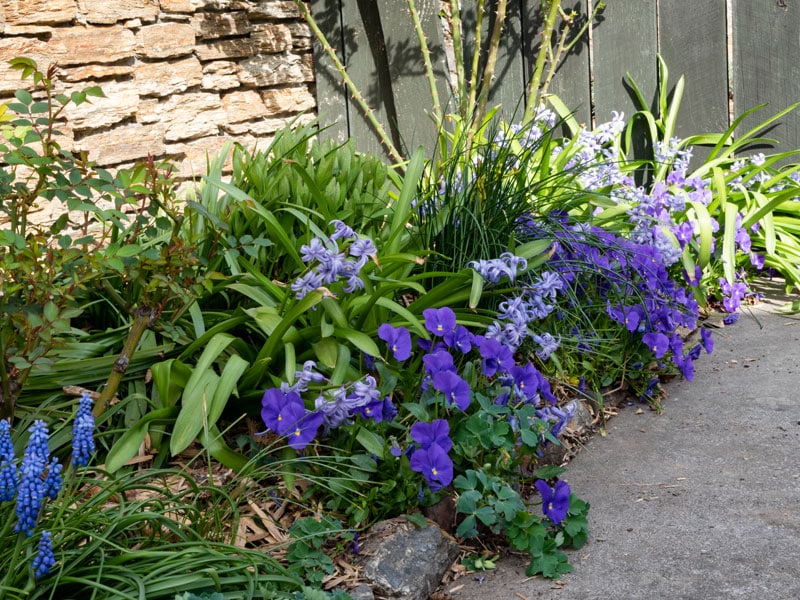
A restricted colour palette
I love lush planting and a variety of plants, so my borders can tend towards the chaotic. Despite this, I feel I could impose more order on my garden design by using a restricted colour palette. This all-blue border, with pansies, hyacinths and muscari also shows how thought has been given to maintaining interest through the season. Roses, paeonies and aquilegias are ready to take over when the earlier-flowering plants have finished.
Using native plants
The familiar cherry blossom trees and viburnum lining a drive is interspersed with native shrubs, coprosma and pittosporum creating a striking entrance to the garden.

Working with the landscape
If you live in a rocky place, make a rock garden! This classic border with its lithodora, pansies and many shades of aubretia sets off the house perfectly in the mountainous landscape. The trees behind give shelter from the prevailing wind.
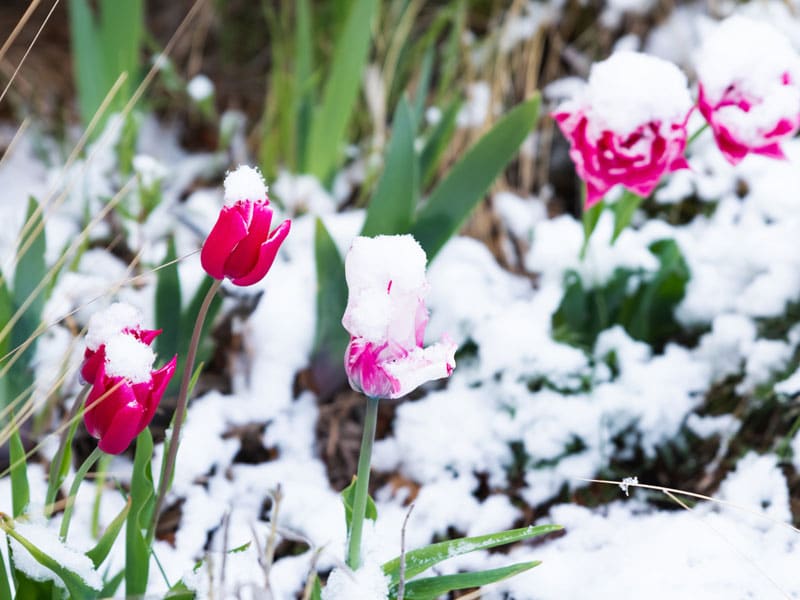
Jobs for November
There is lots to do in November. You’ll be weeding, mowing the lawn, sowing seeds and, if you sowed lots of seeds in October, transplanting seedlings. If you haven’t already restored order, you’ll be able to see where grass from the lawn has invaded the border and plants from the border have invaded the lawn. Redefine the edges of the borders by throwing soil from the front of the border to the back, making a gentle slope.
Keep an eye on the irrigation, especially in late November. As temperatures increase, increase the duration and frequency of any timed irrigation. Hand water newly transplanted seedlings and monitor their progress.
Tender plants can go outside now, so you can put your chillies, basil, aubergines and tomatoes outside.
Seeds to sow
You can direct sow beans, beetroots, borage, carrots, parsnips and radishes. In milk bottles or trays in a sheltered part of the garden, you can sow cape gooseberry (physalis), celery, chicory, Chinese cabbage, coriander, lettuce, parsley, pumpkin, rocket, Swiss chard (they call it silverbeet here), sunflowers, sweet corn and turnips. Indoors, you can sow cucumber, marrow and a few last-minute tomatoes. Plant yam/oca tubers and, if you haven’t done so already, or to extend the season, you can plant seed potatoes.

About the writer
My name’s Pamela and a few years ago, at the age of 55, I made the decision to start a new adventure. I left the northwest of England, where I had lived all my life, and moved to New Zealand. I’m excited to be a guest blogger on Gardenize, and I love writing about my garden in beautiful, sunny Alexandra in Central Otago. My garden here is about as different as it could get from the damp, shady garden I left behind. Central Otago is the hottest, driest, coldest area in New Zealand, as we have hot summers and cold winters, along with a semi-arid climate. The area is famous for its orchards and vineyards. It has many quaint little rural townships with pretty cottage gardens featuring peonies, bearded irises, hollyhocks, lilies, roses, and lavender that grow so well here. The landscape is spectacular, with dry, rocky mountains and impossibly blue lakes and rivers. The dry mountains look barren, but they’ve actually covered in tough little thyme plants: a great clue to what might grow well in the garden.
GARDENIZE GARDEN APP
A gardening friend with a green thumb and photographic memory
Gardenize is an app for gardening and cultivation that helps you to overview, understand and develop your garden and your gardening skills.
Order makes it easier to succeed and Gardenize structures information and photos and makes it searchable for you. You also get tips and inspiration from other Gardenizers around the world.
Gardenize is free to use and you can download Gardenize from the App Store or Google Play, or create an account the Gardenize web app for web browsers.
Get to know Gardenize better here.

